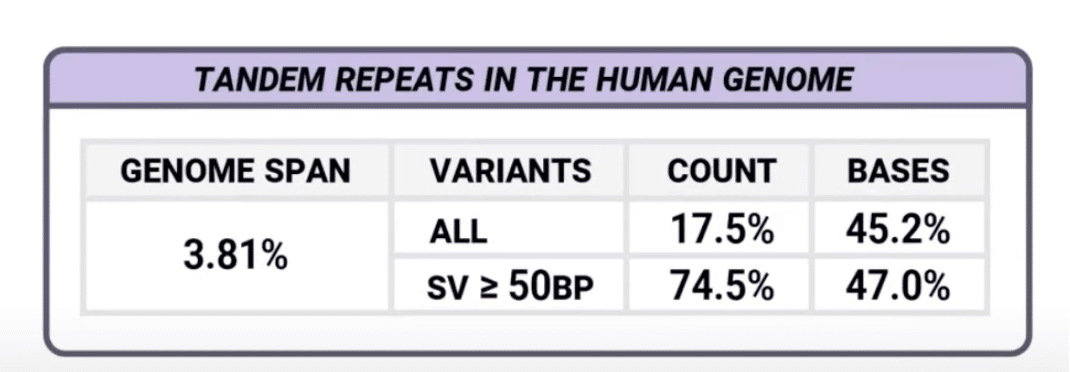
PacBio is helping researchers usher in a new era of genomics with cost-effective tools to accurately identify human disease-causing tandem repeat changes and detailed sequences of specific genes at scale.
After the completion of the first draft of the human genome in the early 2000s, the research and clinical community was brimming with excitement that the milestone had marked the dawn of the genomic age. The first draft held the promise of new technologies and medical breakthroughs.
While this tremendous accomplishment opened new possibilities, there were still discoveries to be made. By the 2010s, the scientific community realized that even the best human genome assemblies of the time contained numerous gaps that needed to be filled and errors that needed to be corrected. In 2021, researchers tackled these challenges by using HiFi reads to assemble the first gapless human reference genome, including centromeric regions and the entire short arms of five human chromosomes.
At PacBio, we are inspired by these advances in genomic discovery and excited to continue creating new technologies to inspire innovation. Recently, we announced Revio, Onso, and MAS-Seq, three new products to provide the most accurate long-read, short-read, and single-cell RNA sequencing data possible.
In conjunction with these releases, we are pleased to also present TRGT with companion tool TRVZ and HiFi targeted enrichment panels, two solutions (software, and chemistry) that extend the game-changing capabilities of PacBio sequencing even further, fueling the ability to confidently disentangle even the most challenging complexities of the genome.
Analyze and visualize tandem repeats with TRGT
A new tandem repeat analysis and visualization tool to achieve comprehensive detection of single nucleotide variants, structural variants, and indels with haplotype resolution.
What are tandem repeats?
A tandem repeat is a length of DNA two or more nucleotides long that is repeated back-to-back (called a repeat motif), anywhere from twice to more than a hundred times on a chromosome.
Because of their repetitive nature, genomic regions containing long tandem repeat sequences have been notoriously difficult to analyze accurately. This is due to the mathematical uncertainties of attempting to piece together and align short reads that cannot span the entire length of the repeat.

Why tandem repeats are important
Despite being what are by-in-large non-coding sections within genes, tandem repeats make up almost 4% of the entire human genome and are highly influential in biology, accounting for most structural variants longer than 50 bp. Because tandem repeats are rarely translated into proteins, these highly repetitive regions are also extremely variable with an important influence on phenotypic variation and a multitude of genetic diseases in humans.

Table: Adam English, Baylor College of Medicine
To date, tandem repeats have been tied to changes in gene expression in cancers and are associated with over 50 nervous system diseases including ALS, FXS, ataxias, autism spectrum disorders, and schizophrenia. Understanding tandem repeats and accurately capturing and cataloging their sequences is the first step in understanding how they drive disease which may one day lead to the discovery of biomarkers, drug targets, and the development of therapeutics.
How TRGT + TRVZ can revolutionize your tandem repeat analysis
PacBio HiFi sequencing combined with the all-new TRGT + TRVZ software solution eliminates the challenges of analyzing tandem repeats with conventional approaches by providing researchers with expansive (>10,000 bp), highly accurate reads (99.9%) and a suite of dedicated analysis tools tuned to the specifics of this unique and powerful data.
TRGT + TRVZ capabilities include:
- Size genotyping and mosaicism estimation
- Sequence composition analysis (including interruptions and regions with multiple repeats)
- 5mC CpG methylation calling
- Visual display of haplotype-resolved read pileup and methylation status
Together, HiFi sequencing and TRGT help eliminate the complex mathematical impediments of the past, freeing researchers to answer critical questions about the role these important genomic regions play in everything from trait evolution to disease biology.
Explore TRGT in greater detail in this on-demand presentation by PacBio scientist and co-developer, Egor Dolzhenko. If you’re ready to try this exciting new analysis tool, TRGT is available now on GitHub.
Get HiFi reads of just the genes you care about at scale
Rapidly increase the throughput and cost-effectiveness of variant detection with HiFi reads using new HiFi target enrichment panels developed in collaboration with Twist Bioscience.
What is target enrichment?
Target enrichment is a general term for a variety of pre-sequencing DNA preparation methods that are used to focus exclusively on a specific gene or region of interest within the genome, greatly enhancing the scale, cost, and resource efficiencies of a sequencing study.
How target enrichment works
To exclude all the extraneous information in the genome and drill down to the specific areas of interest, researchers generally use one of two approaches: amplification of the target using the polymerase chain reaction (PCR) or the physical capture of the target via DNA-DNA hybridization between the sample and a probe.
PCR-based methods (also called targeted amplicon sequencing) involve designing primers for the area(s) of interest and running PCR which replicates the target sequence to such an extent that they completely drown out any unwanted DNA from a sample. These amplified molecules or “amplicons” can then be taken through additional downstream manipulations prior to sequencing, including barcoding and multiplexing. Amplicon enrichment benefits include a relatively straightforward workflow and the ability to study samples with very low DNA input. Disadvantages include difficulty with targeted large or numerous genomic regions and the introduction of data biases inherent to the chemistry of PCR.
The alternative approach, commonly referred to as hybrid capture, benefits from a highly scalable workflow that can be used to quickly optimize for a variety of targeted panels. This is accomplished by first binding a short piece of DNA, commonly referred to as a probe, to the desired piece of sample DNA. Unlike primers used in PCR, probes used in hybrid capture are not used to initiate the synthesis of a complementary strand of DNA. Instead, the probe is bound to a magnetic bead that allows the target molecule to be held in place what the rest of the sample is washed away. This remaining set of molecules are then prepared for sequencing.
The advantages of HiFi target enrichment with Twist panels
PacBio has teamed up with Twist Bioscience to offer target enrichment options that beautifully integrate the strengths of HiFi sequencing and Twist’s proprietary chemistry to get the most information with the least amount of sequencing. Using a hybrid capture approach, Twist target enrichment libraries sequenced with HiFi reads offer these key advantages:
- End-to-end, fully supported workflow optimized for HiFi reads
- Custom design for any panel size
- High-accuracy variant calls, including SVs
- Direct phasing, unambiguous haplotypes, ancestry-agnostic discovery
- Ability to run small and large cohorts on a single SMRT Cell on Sequel IIe and Revio systems
Together these capabilities enable researchers to embark on information-rich exploratory genotyping experiments with the added throughput and cost-savings of a targeted methodology. By homing in on the locus of interest to the exclusion of other genomic regions, a single HiFi sequencing run can achieve significantly greater depth or accommodate more samples than would be possible with a whole genome sequencing approach.
Your partner in the pursuit of discovery
At PacBio, we are committed to being a reliable partner who supports and inspires your scientific success. With TRGT and HiFi enrichment panels you can zero in on the right solutions for your research goals. If you have further questions, connect with us to discuss how PacBio can help turn your research vision into an actionable reality.